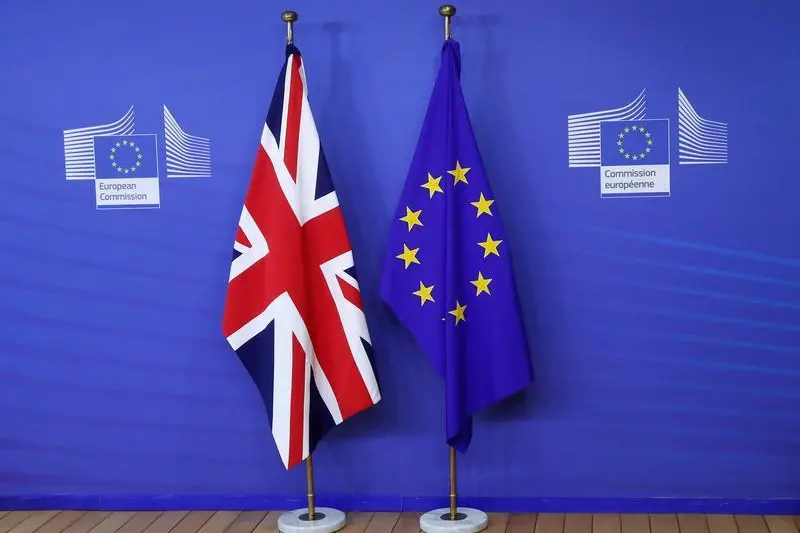PHOTO
LONDON - It’s easy to forget that, until recently, Britain’s relationship with Europe was of little concern to most voters. A month before the 1997 general election, pollster Ipsos MORI asked Britons to name the issues that would decide which party they voted for. Less than a quarter mentioned the European Union. Its salience fell to 14 percent in 2001 and lingered in the single digits for more than a decade. So how did the 2016 referendum lead to the highest turnout in a nationwide vote for 24 years, with the majority siding against the government?
“Brexit and British Politics”, by Oxford University’s Geoffrey Evans and Anand Menon of King’s College London, is the best attempt so far to answer that question. Unlike other academic studies, its argument is tightly focused. It also devotes little space to the political drama in the run-up to the vote.
Evans and Menon argue that most voters made up their minds well before the referendum: support for both the Leave and Remain sides hovered around 40 percent until the summer of 2015, when the proportion of “don’t knows” started to dip. That suggests opinion had crystallised long before the referendum was called.
Long-held euroscepticism provided a baseline of support: about a third of voters opposed membership of the European Economic Community at the time of the last referendum in 1975. A few major trends since then tipped the scales: economic failings like the euro zone debt crisis, an influx of migrants from eastern and central Europe, and a political consensus that left socially conservative voters feeling alienated and ready to defy the mainstream.
Economic arguments were probably less decisive. Asked “what matters to you most when deciding how to vote”, the most popular words used by Remain voters were “economy” and “rights”. Leave supporters preferred “immigration” and “control”.
The association between the EU and migrants is surprisingly recent. In 2004, there was a fairly modest relationship between concerns about immigration and disapproval of the EU. This strengthened over time, and by 2015 support for leaving the EU was 40 percentage points higher among those who believed too many immigrants had been allowed into the country.
What changed? A pivotal moment was Prime Minister Tony Blair’s decision to waive border controls on new members from eastern and central Europe. Blair did so partly on advice from the Home Office, which incorrectly assumed that other countries in Europe would do the same and that the influx would be between 5,000 and 13,000 per year. In 2013, statistics authorities reckoned the actual figure was 50,000.
This fusion of the EU and immigration was a huge boon for the Leave campaign. Even though the proportion of voters who think there are too many immigrants declined from almost 90 percent in 1970 to less than 60 percent by 2014, according to the Migration Observatory, Brexit mobilised this block, which had not had a chance to express displeasure at the ballot box.
But the Leave coalition also shared a social conservatism that Britain’s three major parties had all but ignored for decades. Voters’ opinions of the death penalty, immigration, homosexuality and the role of women in society tend to cluster and broadly correlate with support for Brexit: 80 percent of the most socially conservative voters opted to Leave, against fewer than 10 percent of social liberals. Support for capital punishment is almost as closely tied to Brexit as opposition to immigration.
More doubtful is whether this group is the basis for a sustainable coalition. Evans and Menon point out that support for Brexit splits almost half and half between voters on the left and right of the traditional political spectrum. It also spans at least three distinct social groups: affluent eurosceptics, the older working class, and economically disadvantaged, anti-immigrant voters. As well as distinct views on topics like welfare, the groups have directly opposite economic situations. Prime Minister Theresa May’s attempt this year to unite them cost her Conservative party its parliamentary majority.
That makes it hard to envisage an exit settlement that pleases all. Former UK Independence Party leader Nigel Farage already talks of a “Brexit betrayal” by May and her cabinet colleagues. Economic libertarians who see an opportunity to slash EU regulations have little in common with those focused on cutting immigration or boosting spending on the National Health Service. Voters who wanted to kick back at establishment politicians, meanwhile, may be surprised that Britain has agreed to pay a divorce bill of 40-45 billion euros. Throw in the 48 percent who voted to stay in the EU and Brexit risks disappointing all - potentially adding to the political disaffection that helped fuel the vote in the first place.
CONTEXT NEWS
- “Brexit and British Politics”, by Anand Menon and Geoffrey Evans, was published by Polity Press in November.
(Editing by Peter Thal Larsen and Neil Unmack)
© Reuters News 2017
“Brexit and British Politics”, by Oxford University’s Geoffrey Evans and Anand Menon of King’s College London, is the best attempt so far to answer that question. Unlike other academic studies, its argument is tightly focused. It also devotes little space to the political drama in the run-up to the vote.
Evans and Menon argue that most voters made up their minds well before the referendum: support for both the Leave and Remain sides hovered around 40 percent until the summer of 2015, when the proportion of “don’t knows” started to dip. That suggests opinion had crystallised long before the referendum was called.
Long-held euroscepticism provided a baseline of support: about a third of voters opposed membership of the European Economic Community at the time of the last referendum in 1975. A few major trends since then tipped the scales: economic failings like the euro zone debt crisis, an influx of migrants from eastern and central Europe, and a political consensus that left socially conservative voters feeling alienated and ready to defy the mainstream.
Economic arguments were probably less decisive. Asked “what matters to you most when deciding how to vote”, the most popular words used by Remain voters were “economy” and “rights”. Leave supporters preferred “immigration” and “control”.
The association between the EU and migrants is surprisingly recent. In 2004, there was a fairly modest relationship between concerns about immigration and disapproval of the EU. This strengthened over time, and by 2015 support for leaving the EU was 40 percentage points higher among those who believed too many immigrants had been allowed into the country.
What changed? A pivotal moment was Prime Minister Tony Blair’s decision to waive border controls on new members from eastern and central Europe. Blair did so partly on advice from the Home Office, which incorrectly assumed that other countries in Europe would do the same and that the influx would be between 5,000 and 13,000 per year. In 2013, statistics authorities reckoned the actual figure was 50,000.
This fusion of the EU and immigration was a huge boon for the Leave campaign. Even though the proportion of voters who think there are too many immigrants declined from almost 90 percent in 1970 to less than 60 percent by 2014, according to the Migration Observatory, Brexit mobilised this block, which had not had a chance to express displeasure at the ballot box.
But the Leave coalition also shared a social conservatism that Britain’s three major parties had all but ignored for decades. Voters’ opinions of the death penalty, immigration, homosexuality and the role of women in society tend to cluster and broadly correlate with support for Brexit: 80 percent of the most socially conservative voters opted to Leave, against fewer than 10 percent of social liberals. Support for capital punishment is almost as closely tied to Brexit as opposition to immigration.
More doubtful is whether this group is the basis for a sustainable coalition. Evans and Menon point out that support for Brexit splits almost half and half between voters on the left and right of the traditional political spectrum. It also spans at least three distinct social groups: affluent eurosceptics, the older working class, and economically disadvantaged, anti-immigrant voters. As well as distinct views on topics like welfare, the groups have directly opposite economic situations. Prime Minister Theresa May’s attempt this year to unite them cost her Conservative party its parliamentary majority.
That makes it hard to envisage an exit settlement that pleases all. Former UK Independence Party leader Nigel Farage already talks of a “Brexit betrayal” by May and her cabinet colleagues. Economic libertarians who see an opportunity to slash EU regulations have little in common with those focused on cutting immigration or boosting spending on the National Health Service. Voters who wanted to kick back at establishment politicians, meanwhile, may be surprised that Britain has agreed to pay a divorce bill of 40-45 billion euros. Throw in the 48 percent who voted to stay in the EU and Brexit risks disappointing all - potentially adding to the political disaffection that helped fuel the vote in the first place.
CONTEXT NEWS
- “Brexit and British Politics”, by Anand Menon and Geoffrey Evans, was published by Polity Press in November.
(Editing by Peter Thal Larsen and Neil Unmack)
© Reuters News 2017












